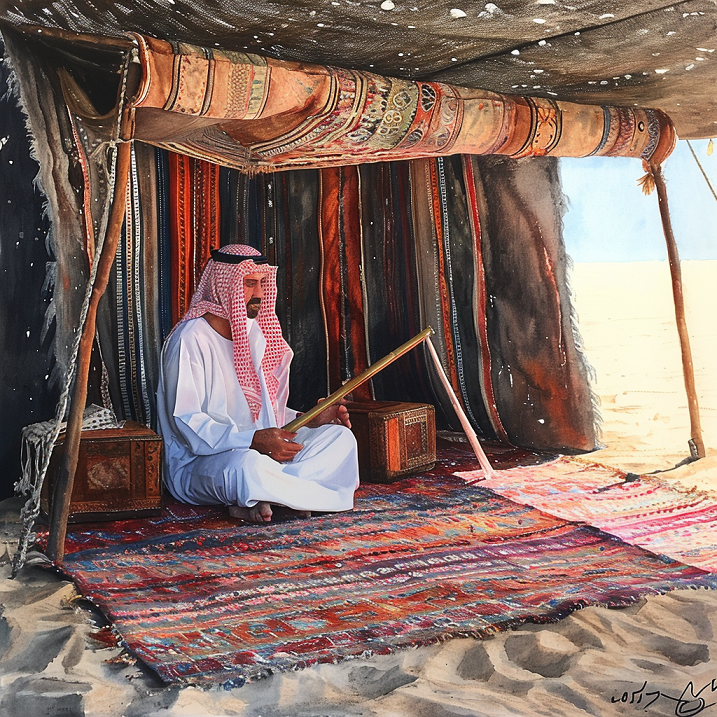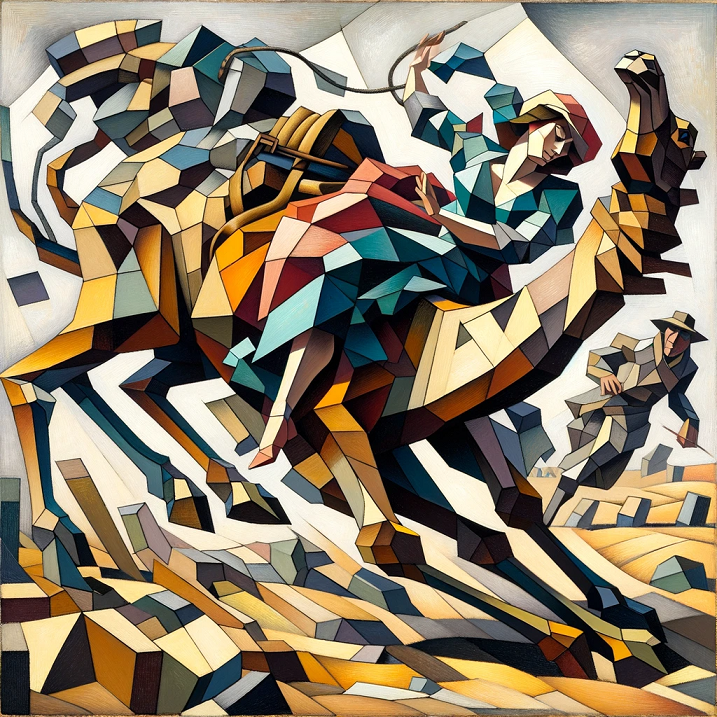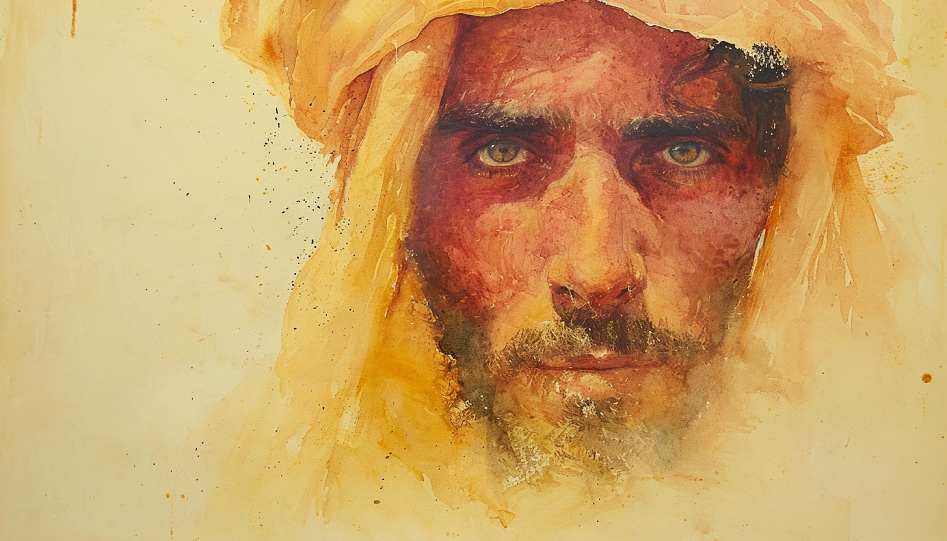Few travel narratives capture the essence of adventure and cultural immersion as vividly as Lady Anne Blunt’s odyssey through the Jordanian desert, a focal narrative in her work, “A Pilgrimage to Nejd.” Lady Blunt’s journey, characterised by encounters with the diverse tribes of the Arabian Peninsula and the challenging elements of the desert, serves as a window into a world both harsh and hospitable, traditional yet dynamic. It is a narrative that intertwines the beauty of the Arabian wilderness with the complexity of Bedouin politics and the enduring allure of discovery.
Ali el-Kreysheh’s Camp and Departure
In the midst of the Jordanian Harrah, Blunt’s party were in search of the camping grounds of the Bani Sakhr, a local tribe with whom they could seek shelter and protection on their journey. After several days travel with hardly any human interaction they were finally at Ali el-Kreysheh’s camp, where they were warmly welcomed and hospitably entertained by his young relative in the Sheykh’s absence who was away at Mezarib with fifty horsemen.
The evening at the camp was enriched with cultural immersion, as the air resonated with the melodies of the rebab, a traditional stringed instrument, and the voices singing old Shammar ballads. Among these, a ballad about Abdul Kerim stood out, narrating tales of a man and his mare, echoing the deep connection between the Arabs and their horses.
As the dawn of December 24th broke, the expedition found themselves amidst the Kreysheh, a segment of the larger Beni Sakhr tribe. The Beni Sakkhr, known as the ‘children of the rocks‘, inhabited the stony expanses of the Harra, from the pilgrim roads eastwards to its furthest reaches. This tribe, distinct from the Ànazeh and identifying as Shimali or Northern Arabs, boasted a lineage stretching back ‘from all time’. They had fragmented into ten divisions, each under the aegis of its own Sheykh, yet collectively under the nominal authority of Fendi el-Faïz and his son Sottan.
Within this tribal tapestry, Lady Blunt encountered stories of regional politics and shifting allegiances. News reached them of Ibn Majil’s separation from Sotamm Ibn Shaalan and movements towards Jawf, stirring the pot of Bedouin politics, notoriously as changeable as desert winds. The Kreysheh themselves, allies of Ibn Majil, were at odds with Sotamm, illustrating the complex web of loyalties and conflicts in the desert.
Amidst these discussions, Lady Blunt took the opportunity to visit Ali el-Kreysheh’s wives, Hazna and Fassal. In the women’s tent, she met only Fassal, who, despite her plainness, exuded a sensible aura. Their conversation touched upon Damascus and local figures of renown, revealing Fassal’s keen interest in the wider world beyond the desert’s confines.

She told me she was from a section of the tribe further north, and took an interest in Damascus, asking about the new Yaly as well as about Mohammed ibn Smeyr, who is the great name in these parts. She seemed much pleased with the box of sugar-plums I gave her, and when I went away followed me as far as the end of the tent ropes invoking blessings on my head.
Lady Anne Blunt: A Pilgrimage to Nejd, The Cradle of the Arab Race
As preparations were made for departure, a guide was arranged to escort them to Kaf for ten mejidies. This phase of the journey saw a poignant farewell to her guides, Assad and Salman who had to return to Melakh. Their departure was sweetened with a Turkish pound each, a token of gratitude for their companionship and guidance. In a touching moment, Assad’s greyhound, a black and tan dog, displayed its loyalty by whining piteously at the departure of its master, a sentiment that resonated with Lady Blunt, affirming her fondness for the faithful animal.
Harsh Desert Conditions and Discoveries
As Lady Anne Blunt’s caravan ventured further into the heart of the desert, they were greeted by the harsh reality of their surroundings. A biting wind swept across the landscape, chilling them to the bone despite their layers of furs and cloaks. Their path led them across a monotonous plain, a sea of black stones under an unyielding sky, each step a testament to the relentless nature of the desert.
Amidst this barren expanse, they encountered Khabra-el-Gurrthi, a vast flat of dried clay and sand. This desolate stretch, whipped by winds that carried clouds of sand, presented a dreary and daunting challenge. The group, huddled on their deluls (camels), braved the elements in silence, each lost in their thoughts amidst the desolation.
As they journeyed, the sight of the Wady er-Rajel appeared like a mirage turned real. The valley, with its soft ground and patches of grass, offered a stark contrast to the stony wasteland they had traversed. Pools of water, remnants of last month’s rains, provided a much-needed respite. Here, they decided to set camp for the night. The setting was idyllic compared to the day’s hardships – a serene oasis in the midst of the desert’s austerity.
The night of December 24th brought with it an unexpected Christmas Eve celebration in the desert. The group huddled around a warming meal of curry, soup, burghul, and a plum-pudding from a tin – a humble yet heartening feast far from the traditional yuletide festivities. Their spirits were lifted despite the cold, as they found comfort in the simple pleasures of a meal shared under the starlit sky of the Arabian desert.
Christmas Day in the Desert
On the morning of December 25th, Christmas Day, Lady Anne Blunt and her party bid farewell to the Harra’s blackened landscape, entering a more open and forgiving terrain. This transition marked a significant shift in their journey, as they were able to increase their pace across the rolling downs, a welcome relief from the harsh, boulder-strewn paths of the Harra.
The journey continued with discussions among the group about the potential risks of encountering hostile tribes or robbers. In the Bedouin world, such occurrences were accepted as part of life, as natural and unpredictable as the weather. The group’s philosophy of accepting whatever came their way, whether it be good fortune or adversity, mirrored the Bedouin ethos of resilience and adaptability.
They, however, have settled it among them to their satisfaction, that such accidents as meeting robbers or people of a hostile tribe are ” min Allah ” (from God), to be classed with the rain and fine weather, and sickness and good health, all which things the Bedouins consider fortuitous.
Lady Anne Blunt: A Pilgrimage to Nejd, The Cradle of the Arab Race
As they left the Wady er-Rajel, their path took them across rolling downs covered in light flinty gravel, a stark contrast to the Harra. The sight of gazelles prompted spontaneous hunting attempts, though success eluded them. The dogs, even the skilled greyhounds, struggled to match the agility of the desert’s native fauna.
Surviving a Desert Sand Strom
As Lady Anne Blunt’s expedition persevered through the desert, they encountered a solitary young camel, astray in the vast wilderness. Seizing the opportunity presented by this stroke of luck, the group enthusiastically claimed the camel, an act justified by the unwritten laws of the desert where astray animals are considered fair game for the first comer. This unexpected find not only provided them with much-needed sustenance but also served as a reminder of the harsh realities and opportunistic nature of survival in the desert.
The journey, however, was not without its challenges. In the early hours of the following morning, a fierce sandstorm struck, bringing with it a deafening roar and overwhelming force. The storm’s intensity was such that their tents collapsed, enveloping the group in a chaotic swirl of fabric and sand. Despite the initial disarray, they managed to find shelter beneath the ruins of their tents, a temporary respite from the storm’s fury.
The servants having thus feasted were all soon sound asleep, and even when suddenly, between two and three in the morning, the wind rose with a deafening noise, they did not wake, not till their tent blew down upon them as ours did upon us. We were awake and might have kept our tent standing had we not been too lazy to get up and drive in the pegs. It was too late when the tent had fallen on us to do anything but lie as well as we could beneath the ruins and wait for daylight.
Lady Anne Blunt: A Pilgrimage to Nejd, The Cradle of the Arab Race
In the midst of the storm, they found an unexpected haven under tamarisk bushes, where the wind’s fury was somewhat tempered. Here, they made a fire, enjoying Hanna’s coffee and finding comfort in the small oasis of calm they had created. The storm, while a formidable obstacle, highlighted the resilience and adaptability of Lady Blunt and her party, as they navigated the unpredictability of the desert with determination and ingenuity.
Arrival at Kaf
After enduring the challenges posed by the desert, Lady Anne Blunt’s party finally reached their destination, the small oasis of Kaf. The journey to Kaf was marked by a transformative change in the landscape, from the harshness of the Harra to the rolling downs and finally to the sight of the great Wadi Sirhan. The discovery of this ancient sea bed, now a vast valley, was a moment of awe and revelation for the group. The oasis of Kaf, a minuscule village with its modest palm garden, appeared as a welcome sign of habitation in the vast desert.
Lady Blunt’s Accident
However, the journey was not without its misfortunes. Lady Blunt suffered a painful accident, spraining her knee when her delul (camel) bolted unexpectedly. This injury, occurring in the midst of a demanding expedition, presented a significant challenge and discomfort for Lady Blunt, threatening to impede the progress of their journey. Her description of the incident conveys both the physical pain of the fall and the frustration at the untimely setback.
My delul, always a fidgety animal, gave a bolt just as I was leaning over to arrange something on the off side of the shedd, or saddle, and pitched me off. The pain is indescribable, and I fear I shall be helplessly lame for some time to come.
Lady Anne Blunt: A Pilgrimage to Nejd, The Cradle of the Arab Race

Despite the injury, the arrival at Kaf marked a significant milestone in their journey. The group had navigated the unpredictable terrains of the Arabian desert, encountering both its merciless challenges and its moments of serendipity. As they settled in the small oasis of Kaf, the journey’s trials and triumphs reflected the complex beauty and harsh reality of the Arabian landscape and the indomitable human spirit that seeks to traverse it.

